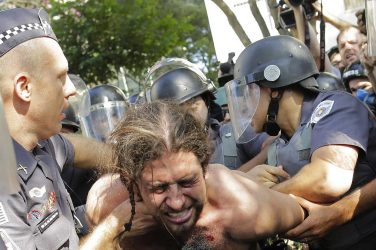The murder of a group of street children in Rio de Janeiro sent shockwaves around the world 25 years ago. The Candelária massacre showed a side of Brazil that doesn’t make the postcards, but is still a reality today.
That evening, Yvonne Bezerra de Mello had a premonition. “I gave three boys a coin so they could call me if something was wrong,” she says. Then she left the group of 70 street children, who were sleeping rough outside the Candelária Church in the center of Rio de Janeiro.
The date was July 23, 1993. Back then Bezerra was trying to help the children, whom the state had completely abandoned to their fate. The youngest of them was six years old, the oldest in their early twenties.
“That night, the calls came,” says Bezerra. “The boys were shouting, “They’re killing us.”
Today, a quarter of a century later, Yvonne Bezerra is an educator with an international reputation, but what happened that Friday night has shaped her entire life.
It became known as the Candelária Massacre, and it attracted worldwide attention — partly because it showed a very different Brazil to the one on the postcards: a merciless, brutal, socially divided Brazil. “A country that is still that way today,” says Yvonne Bezerra.
From her large apartment in Rio’s Flamengo district, Bezerra, 61, tells the story of the massacre. A couple of times she gets out some old photos to illustrate it. “When I got to the Candelária half an hour later there were bodies in front of the church,” she remembers. The children were absolutely terrified.
Eight children and young people aged between 11 and 19 were shot dead that night. It soon emerged that the perpetrators were policemen. They were from the 5th Battalion of Rio’s military police, which had a sort of death squad whose members were also involved in drug dealing.
An Unpaid Debt?
There are different versions of what exactly prompted the policemen to carry out the massacre. It seems that the youngsters had thrown a stone at a police car, which goaded them on.
However, Yvonne Bezerra is convinced that it was more about settling scores. “The police were dealing cocaine, and some of the older kids were helping them,” she says. Her explanation is that the police took revenge because the kids owed them money.
Seven people stood trial for the murders; three policemen were convicted. One defendant was killed during the investigation, presumably to cover the murderers’ tracks. All three of those convicted are already out of prison. Two were freed before the end of their sentences.
The main culprit, Marcus Vinicius Emmanuel Borges, was pardoned after serving 18 years of a 300-year sentence, but the pardon was rescinded a year later. He failed to appear when an arrest warrant was put out and is considered a fugitive.
“In this society, poor people and black people don’t count,” says Yvonne Bezerra. At the time she was vilified as an accomplice of the “vagabonds,” as the street kids were called. There were many people who found their presence disturbing, and Bezerra says that in some quarters the massacre was regarded as necessary social cleansing.
For Bezerra, July 23, 1993 was a turning point. From then on she devoted her life to working with children. She founded the renowned educational project Uere, which now runs a school in the favela complex of Maré. To this day she still receives threats as a result of her social engagement.
‘None of the Children Made It to 50’
Bezerra believes that all of the street children from the Candelária Church are now dead. She maintained contact with some of them for many years, but the last survivor she knew was killed recently by a ricocheting bullet in Maré.
“None of the children made it to 50,” she says. “Their lives were always marked by violence.” One of the traumatized survivors, Sandro do Nascimento, became known for hijacking a bus with a revolver in 2000. He was asphyxiated shortly afterwards in police custody. The Brazilian documentary film “Bus 174,” directed by Jose Padilha, tells the story of the hijacking.
There is one survivor of that night in 1993. Wagner dos Santos’ involvement was more or less accidental. After the police had shot six children outside the Candelária Church, they began searching the surrounding area for more victims.
Dos Santos happened to be standing near two street kids and the police tried to kill him, too. He was hit by four bullets, one of which hit him in the face, but he survived and went on to become the key witness in the trial. As a result he was targeted again in another attack — another four bullets, which once again he survived.
Sole Survivor Lives in Switzerland
Today Dos Santos is 45 years old and lives in Switzerland, for his own safety. “He is blind in one eye and deaf in one ear, and he suffers from severe trauma,” says his sister Patricia Oliveira.
She sits on a sofa in the office of the organization “Rede de Comunidades e Movimentos contra a Violência” [Network of Communities and Movements Against Violence] in the center of Rio, an organization she founded herself.
She reports that her brother does not believe in justice in Brazil, and says that nothing has changed with regard to the conditions that led to the massacre. The police are still killing young black men with no repercussions, she says.
Today, Wagner dos Santos receives a pension from the Brazilian state equivalent to 420 euros (US$ 490). “He wants to finally leave the massacre behind,” says his sister Oliveira. “But how is he supposed to forget this violence?”
Massacres Still Happening Today
Yvonne Bezerra also believes that nothing has changed in Brazil since 1993. “State and society tolerate massacres of the poor,” she says. Just one month after the Candelária attack, a police death squad murdered 21 people in Rio’s Vigário Geral favela. Of the 52 people who stood trial, seven were convicted, of whom only one remains in custody.
To this day the Brazilian police are still murdering impoverished young black people, especially in Rio de Janeiro. This is compounded by the drug violence in the favelas, which the state allows to continue.
Yvonne Bezerra has the statistics: In 1993 around 11,000 young people in Brazil died a violent death. Nowadays, the annual figure is around 28,000. It’s a gradual genocide.
Amnesty International Reaction
The struggle to protect black Brazilian youths from police violence and deliver justice for the victims of the past remains as vital and relevant as ever, Amnesty International said on the 25th anniversary of the Candelária massacre, in which eight young boys were killed by off-duty police officers in Rio de Janeiro.
The murder of the boys, who were sleeping rough near the city’s Candelária Church on 23 July, 1993, sparked international outrage. Yet today Brazilian police and other state agents continue to form “extermination” groups who remain one of the main drivers of violence in Rio.
“Police violence in Rio de Janeiro has been stimulated by the state’s own policies in the 1990s, which rewarded officers based on the number of ‘criminals’ they killed,” said Jurema Werneck, Executive Director of Amnesty International Brazil.
“The repercussions of this inhumane approach are felt to this day. Instead of guiding the police to protect and preserve life, the state has reinforced the notion that the police’s role is to kill.”
In the wake of the killings at Candelária, Amnesty International denounced violations by the police and joined the victims’ families’ movement for justice, truth and reparation.
The organization did the same when, just a month later, an “extermination group” formed by police officers killed another 21 people – mainly young black men – in Rio’s Vigário Geral favela.
The police’s violent approach in the 1990s was inflamed by government initiatives such as the “Western Gratification” policy, a financial reward for “bravery” that was measured by the number of people killed; and by official government statements supporting the executions.
Today, some of those members of police “extermination” groups occupy prominent positions in the state apparatus, further bolstering impunity.
In response to unchecked violence by police and other state agents, a movement formed by mothers of victims has blossomed.
Organized during the mourning period and the fight for justice that followed the horrendous killings in the 1990s, the groups have since expanded their support and solidarity networks and gained increased prominence.
The mothers’ detailed monitoring of cases and unrelenting demands for justice have made them key players in the campaign to hold security forces accountable for human rights violations.
They have denounced the endemic racism within the security forces which has fueled the killings of youths, especially black people from favelas and other poor suburbs.
The mothers’ ultimate goal is to prevent the police violence that took the lives of their children being repeated for other families.
“The mothers have given visibility to issues previously treated with indifference in the national public agenda, and their struggle is vital in pressuring the Brazilian authorities to create a new public security policy that values life,” said Jurema Werneck.
DW/MP






